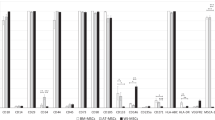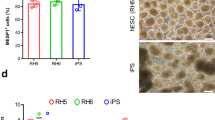Abstract
In view of the possible crosstalks between hematopoiesis and neuropoiesis, we evaluated two microenvironments, murine neonatal neural cell line C17.2 and primary embryonic aorta–gonad–mesonephros (AGM) stromal cells, on the ex vivo expansion of CD34+ cells from human cord blood. In a contact culture system, C17.2 or AGM cells significantly enhanced the expansion of CD34+ cells to a panel of early and committed hematopoietic progenitor cells. In a noncontact transwell system, pre-established C17.2 cells significantly increased the expansion of total nucleated cells, CD34+ cells and multilineage colony forming cells (P<0.01). Expanded cells were infused into nonobese diabetic/severe-combined immunodeficient mice. The engraftment of human (hu)CD45+ cells in the bone marrow of these mice was consistently higher in all the 10 experiments conducted with the support of C17.2 cells when compared with those in respective control groups (11.9 vs 2.43%, P=0.03). Using RT-PCR and Southern blot analysis, we showed that AGM and C17.2 cells expressed a panel of hematopoietic, bone morphogenetic and neurotrophic factors. Our data provided the first evidence on the promoting effects of a neural progenitor cell line on hematopoiesis at a noncontact condition. The mechanism could be mediated by the expression of multilineage regulatory factors.
This is a preview of subscription content, access via your institution
Access options
Subscribe to this journal
Receive 12 print issues and online access
$259.00 per year
only $21.58 per issue
Buy this article
- Purchase on Springer Link
- Instant access to full article PDF
Prices may be subject to local taxes which are calculated during checkout





Similar content being viewed by others
References
Gluckman E . Current status of umbilical cord blood hematopoietic stem cell transplantation. Exp Hematol 2000; 28: 1197–1205.
Rubinstein P, Carrier C, Scaradavou A, Kurtzberg J, Adamson J, Migliaccio AR et al. Outcomes among 562 recipients of placental-blood transplants from unrelated donors. N Engl J Med 1998; 339: 1565–1577.
Rocha V, Wagner Jr JE, Sobocinski KA, Klein JP, Zhang MJ, Horowitz MM et al. Graft-versus-host disease in children who have received a cord-blood or bone marrow transplant from an HLA-identical sibling: Eurocord and International Bone Marrow Transplant Registry Working Committee on Alternative Donor and Stem Cell Sources. N Engl J Med 2000; 342: 1846–1854.
Locatelli F, Rocha V, Chastang C, Arcese W, Michel G, Abecasis M et al. Factors associated with outcome after cord blood transplantation in children with acute leukemia: Eurocord-Cord Blood Transplant Group. Blood 1999; 93: 3662–3671.
Jaroscak J, Goltry K, Smith A, Waters-Pick B, Martin PL, Driscoll TA et al. Augmentation of umbilical cord blood (UCB) transplantation with ex vivo-expanded UCB cells: results of a phase 1 trial using the AastromReplicell System. Blood 2003; 101: 5061–5067.
Stiff P, Chen B, Franklin W, Oldenberg D, Hsi E, Bayer R et al. Autologous transplantation of ex vivo expanded bone marrow cells grown from small aliquots after high-dose chemotherapy for breast cancer. Blood 2000; 95: 2169–2174.
Paquette RL, Dergham ST, Karpf E, Wang HJ, Slamon DJ, Souza L et al. Ex vivo expanded unselected peripheral blood: progenitor cells reduce posttransplantation neutropenia, thrombocytopenia, and anemia in patients with breast cancer. Blood 2000; 96: 2385–2390.
Reichle A, Zaiss M, Rothe G, Schmitz G, Andressen R . Autologous tandem transplantation: almost complete reduction of neutropenic fever following the second transplantation by ex vivo expanded autologous myeloid postprogenitor cells. Bone Marrow Transplant 2003; 32: 299–305.
McNiece IK, Almeida-Porada G, Shpall EJ, Zanjani E . Ex vivo expanded cord blood cells provide rapid engraftment in fetal sheep but lack long-term engrafting potential. Exp Hematol 2002; 30: 612–616.
Terskikh AV, Easterday MC, Li L, Hood L, Kornblum HI, Geschwind DH et al. From hematopoiesis to neuropoiesis: evidence of overlapping genetic programs. Proc Natl Acad Sci USA 2001; 98: 7934–7939.
Jay KE, Gallacher L, Bhatia M . Emergence of muscle and neural hematopoiesis in humans. Blood 2002; 100: 3193–3202.
Snyder EY, Park KI, Flax JD, Liu S, Rosario CM, Yandava BD et al. Potential of neural ‘stem-like’ cells for gene therapy and repair of the degenerating central nervous system. Adv Neurol 1997; 72: 121–132.
Sanchez MJ, Holmes A, Miles C, Dzierzak E . Characterization of the first definitive hematopoietic stem cells in the AGM and liver of the mouse embryo. Immunity 1996; 5: 513–525.
Medvinsky A, Dzierzak E . Definitive hematopoiesis is autonomously initiated by the AGM region. Cell 1996; 86: 897–906.
Su RJ, Zhang XB, Li K, Yang M, Li CK, Fok TF et al. Platelet-derived growth factor promotes ex vivo expansion of CD34+ cells from human cord blood and enhances LTC-IC, NOD/SCID repopulating cells and formation of adherent cells. Br J Haematol 2002; 117: 735–746.
Zhang XB, Li K, Yau KH, Tsang KS, Fok TF, Li CK et al. Trehalose ameliorates the cryopreservation of cord blood in a preclinical system and increases the recovery of CFUs, long-term culture-initiating cells, and nonobese diabetic–SCID repopulating cells. Transfusion 2003; 43: 265–272.
Chui CMY, Li K, Yang M, Chuen CKY, Fok TF, Li CK et al. Platelet-derived growth factor up-regulates the expression of transcription factors NF-E2, GATA-1 and c-Fos in megakaryocytic cell lines. Cytokine 2003; 21: 51–64.
Handgretinger R, Gordon PR, Leimig T, Chen X, Bühring H-J, Niethammer D et al. Biology and plasticity of CD133+ hematopoietic stem cells. Ann NY Acad Sci 2003; 996: 141–151.
Ohneda O, Fennie C, Zheng Z, Donahue C, La H, Villacorta R et al. Hematopoietic stem cell maintenance and differentiation are supported by embryonic aorta–gonad–mesonephros region-derived endothelium. Blood 1998; 92: 908–919.
Xu M, Tsuji K, Ueda T, Mukouyame Y, Hara T, Yang F et al. Stimulation of mouse and human primitive hematopoiesis by murine embryonic aorta–gonad–mesonephros-derived stromal cell lines. Blood 1998; 92: 2032–2040.
Nishikawa M, Tahara T, Hinohara A, Miyajima A, Nakahata T, Shimosaka A . Role of the microenvironment of the embryonic aorta–gonad–mesonephros region in hematopoiesis. Ann NY Acad Sci 2001; 983: 109–116.
Kusadasi N, Oostendorp RAJ, Koevoet WJLM, Dzierzak EA, Ploemacher RE . Stromal cells from murine embryonic aorta–gonad–mesonephros region, liver and gut mesentery expand human umbilical cord blood-derived CAFCweek6 in extended long-term cultures. Leukemia 2002; 16: 1782–1790.
Charbord P, Oostendorp R, Pang W, Hérault O, Noel F, Tsuji T et al. Comparative study of stromal cell lines derived from embryonic, fetal, and postnatal mouse blood-forming tissues. Exp Hematol 2002; 30: 1202–1210.
Chute JP, Saini AA, Chute DJ, Wells MR, Clark WB, Harlan DM et al. Ex vivo culture with human brain endothelial cells increases the SCID-repopulating capacity of adult human bone marrow. Blood 2002; 100: 4433–4439.
Canalis E, Economides AN, Gazzerro E . Bone morphogenetic proteins, their antagonists, and the skeleton. Endocr Rev 2003; 24: 218–235.
Chadwick K, Wang L, Li L, Menendez P, Murdoch B, Rouleau A et al. Cytokines and BMP-4 promote hematopoietic differentiation of human embryonic stem cells. Blood 2003; 102: 906–915.
Detmer K, Walker AN . Bone morphogenetic proteins act synergistically with haematopoietic cytokines in the differentiation of haematopoietic progenitors. Cytokine 2002; 17: 36–42.
Maguer-Satta V, Bartholin L, Jeanpierre S, French M, Martel S, Magaud J-P et al. Regulation of human erythropoiesis by activin A, BMP2, and BMP4, member of the TGFβ family. Exp Cell Res 2003; 282: 110–120.
Dono R . Fibroblast growth factors as regulators of central nervous system development and function. Am J Physiol Regul Integr Comp Physiol 2003; 284: R867–R881.
Kashiwakura I, Takahashi TA . Basic fibroblast growth factor-stimulated ex vivo expansion of haematopoietic progenitor cells from human placental and umbilical cord blood. Br J Haematol 2003; 122: 479–488.
Carmeliet P . Blood vessels and nerves: common signals, pathways and diseases. Nat Rev Genet 2003; 4: 710–720.
Gerber H-P, Malik AK, Solar GP, Sherman D, Liang XH, Meng G et al. VEGF regulates haematopoietic stem cell survival by an internal autocrine loop mechanism. Nature 2002; 417: 954–958.
Simone MD, De Santis S, Vigneti E, Papa G, Amadori S, Aloe L . Nerve growth factor: a survey of activity on immune and hematopoietic cells. Hematol Oncol 1999; 17: 1–10.
Dormady SP, Bashayan O, Dougherty R, Zhang XM, Basch RS . Immortalized multipotential mesenchymal cells and the hematopoietic microenvironment. J Hermatother Stem Cell Res 2001; 10: 125–140.
Zumkeller W, Burdach S . The insulin-like growth factor system in normal and malignant hematopoietic cells. Blood 1999; 94: 3653–3657.
Terskikh AV, Easterday MC, Li L, Hood L, Kornblum HI, Geschwind DH et al. From hematopoiesis to neuropoiesis: evidence of overlapping genetic programs. Proc Natl Acad Sci USA 2001; 98: 7934–7939.
Zhao L-R, Duan W-M, Reyes M, Keene CD, Verfaillie CM, Low WC . Human bone marrow stem cells exhibit neural phenotypes and ameliorate neurological deficits after grafting into the ischemic brain of rats. Exp Neurol 2002; 174: 11–20.
Shih CC, DiGiusto D, Mamelak A, Lebon T, Forman SJ . Hematopoietic potential of neural stem cells: plasticity versus heterogeneity. Leuk Lymphoma 2002; 43: 2263–2268.
Digicaylioglu M, Lipton SA . Erythropoietin-mediated neuroprotection involves cross-talk between Jak2 and NK-κB signalling cascades. Nature 2001; 412: 641–647.
Yang M, Xia WJ, Li KKH, Chik KW, Pong NH, Li CK et al. TPO has neural regeneration effect. Blood 2003; 102: 393b.
Acknowledgements
We thank the late Dr David Walsh for his support on our research program, and nurses of the Labour Ward for their assistance in collecting umbilical cord blood. This study was financially supported by the Hong Kong Paediatrics Bone Marrow Transplant Fund, The Chinese University of Hong Kong and the Industrial Support Fund AF/203/98, Department of Industry, Hong Kong Government Special Administrative Region.
Author information
Authors and Affiliations
Corresponding author
Additional information
Supplementary Information
Supplementary Information accompanies the paper on the Leukemia website (http://www.nature.com/leu).
Rights and permissions
About this article
Cite this article
Li, K., Lee, S., Su, R. et al. Multipotent neural precursors express neural and hematopoietic factors, and enhance ex vivo expansion of cord blood CD34+ cells, colony forming units and NOD/SCID-repopulating cells in contact and noncontact cultures. Leukemia 19, 91–97 (2005). https://doi.org/10.1038/sj.leu.2403542
Received:
Accepted:
Published:
Issue Date:
DOI: https://doi.org/10.1038/sj.leu.2403542



